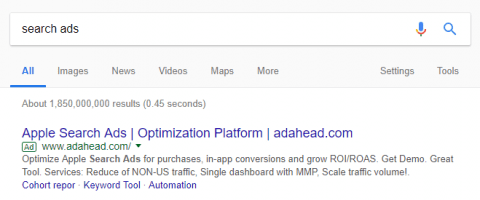
Search engine technology is evolving, and so is the digital marketing industry. The more experienced professionals amongst you may remember the days of gleefully stuffing keywords into your copy to boost your rankings, blindly spamming strangers to join your email lists and easily securing media coverage for your thinly veiled advertisements.
These days are gone for good and they have been replaced with sophisticated algorithms that have turned our industry into a fascinating amalgamation of art and science. As the most popular search engines, artificial intelligence and even our own search habits all evolve over time, we need a new approach to drive the best possible results for your business.
With so many companies competing for search engine supremacy with both agencies and in-house marketers, how do you ensure that your strategy is the right strategy? It all starts with how you structure it:
Converged Media Strategy
At Koozai, we call this “the sweet spot”, but the preferred industry name for this structure is “converged media”. I’ve also seen it called the “digital marketing trifecta”. Knowing this, few of you will be too surprised to hear it involves a three-pronged approach to your online strategy.
Definition: A converged media strategy is a marketing plan that encompasses owned, earned and paid media elements. Each channel will have its own goals, tasks and metrics that define it, but they must all work together to achieve your strategic business goals.
It is crucial to understand that all of these elements need to work together, and the more integrated a strategy can be, the more likely it is to drive success for your business. If each of the channels works too independently, they can drive the business in different and sometimes even contradictory directions.
Most businesses will work towards the following three general goals for their digital marketing strategy in some form:
- Drive more leads to their website
- Grow their audience size
- Establish and maintain a position of authority in their industry
Working with these three goals as an overarching basis for a converged media strategy, we can then look into the individual areas and the impact they can have on these goals.
Paid Media
Definition: paid media is defined as any digital activity where you make a payment in exchange for placement of your advertising on a website or social media platform, or for each click through a search engine. A paid media strategy will often include search ads, display ads and social media advertising methods.
| Key Paid Media Metrics | |
| Acronym | Meaning |
| CPA | Cost per acquisition |
| CPC | Cost per click |
| ROAS | Return on ad spend |
| ROI | Return on investment |
| CTR | Click-through rate |
| CPM | Cost per thousand |
| IS | Impression share |
Paid media is primarily used as a platform for driving more leads from a popular website or social media platform to your websites through advertising. Most companies that use paid media will be using it to bring new prospects into their websites that can then be converted through their on-site content.
At a more advanced level, there is significant potential for growing your audience or establishing a position of authority in your industry, but the primary goal is usually to drive traffic, leads and conversions for your business.
To achieve this, there are three categories when it comes to paid media:
Search ads: Whenever a search is completed on Google, the results will feature a number of paid adverts. These are usually given prominent positions at the top or to the side of the organic results, since the search engines know that these positions provide stronger conversion rates and so they can charge more for their advertisements.
This example demonstrates an advertisement for “search ads”, which is a very competitive term when it comes to organic rankings. At a very basic level, this kind of intelligence can be used to drive decisions on whether or not we should target a keyword through paid or owned media campaigns, or a combination of the two. This is the foundation of a converged media strategy, as we look to identify the opportunities on offer and the best methods for pursuing them.
Display ads: These are most frequently seen as banner ads appearing around publishers’ content. The more popular, respected and authoritative the website is considered to be, the more valuable it is to advertisers looking to promote on them.
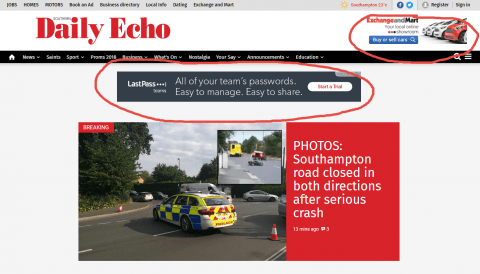 In this example from the Southern Daily Echo website, you can see two sets of banner ads have been displayed:
In this example from the Southern Daily Echo website, you can see two sets of banner ads have been displayed:
There are a number of approaches that digital marketers can take to display ads. They can look to gain placement on a competitor’s website, serve adverts to popular industry-specific websites or even just approach broader news outlets based purely on their popularity.
It is also possible to target users based on their interests and demographic categorisations. The display ad providers offer targeting that allows you to draw on information collected over time; this provides a strong indication of the subjects that matter to users, allowing you to determine the best placements for your paid advertisements.
Social media ads: Whilst social networks provide advertising spaces around their content, they also place adverts within their feeds so that visitors consume them as part of the content. You can see this on my timeline today:
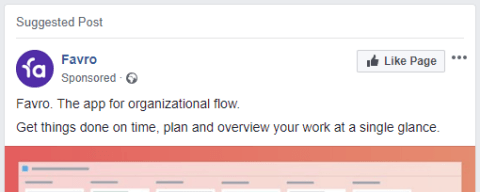 These ads are targeted based on information that I have provided to the social network and my behaviour in relation to other business, pages and groups that appear to be similar to Favro. Social media advertising has traditionally been cheaper than search or display ads, although the limited supply of ad space, especially on Facebook, means it’s likely we will see these numbers come closer together over time.
These ads are targeted based on information that I have provided to the social network and my behaviour in relation to other business, pages and groups that appear to be similar to Favro. Social media advertising has traditionally been cheaper than search or display ads, although the limited supply of ad space, especially on Facebook, means it’s likely we will see these numbers come closer together over time.
Owned Media
Definition: Owned media is defined as the platforms, digital assets and online property that you possess. This possession means that the content on your website is not controlled by other brands and this web property is uniquely your company’s. From a digital marketing perspective, this encompasses search engine optimisation (SEO), organic social media and content marketing efforts.
| Key Owned Media Metrics | ||||
| Traffic | Unique sessions | Organic keyword rankings | Visibility | Goal conversions |
| Bounce rate | Subscribers | Trust flow | Citation flow | Referring domains |
SEO: The process of improving your owned media platforms so that search engines trust your website as an authoritative domain on your chosen subject matter. Our aim through SEO is to ensure that the search engines understand your value and want to share that value with as much organic traffic as possible.
There is a huge range of activity that is involved in world-class SEO and the range of those activities is increasing all the time, as Google in particular alters its algorithms over time. More recent developments in SEO include elements like featured snippets and structured data. This is an example of the structured data for Koozai which demonstrates the kind of key information that can be presented by a business.
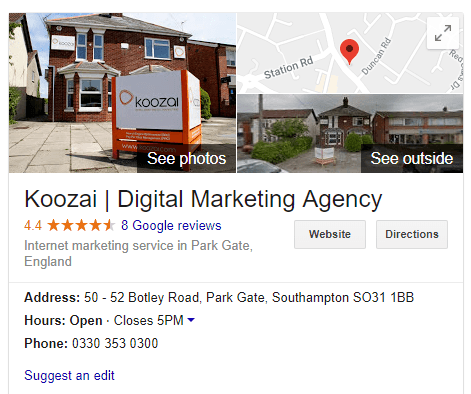
Finding and pursuing these opportunities for your business ensures that searchers are more likely to find your website, driving additional traffic and leads through your business.
Keeping up with the changes is crucial to your success with SEO, as best practices are frequently changing. An extreme example is that 15 years ago, strategies like hiding keywords in white text on white backgrounds used to benefit your website. As the algorithms get more sophisticated, the technical side of SEO becomes more difficult, takes longer to master and, frankly, becomes more interesting/important as a factor in your success or failure as a business.
Content: This encompasses how we present valuable information to our audience online. It begins with the copy on our website but also includes any presentation of information in any format. The purpose of your content is primarily to improve your credibility and trustworthiness so that the search engines will drive higher amounts of more relevant traffic to your website.
Content marketing is designed to ensure that people get the most possible value from you. With this in mind, the goal should be to create valuable content that answers questions for your audience. From there, provided you have given them the answers they need, you then earn the right to attempt to convert them into fans, subscribers and ultimately into paying customers.
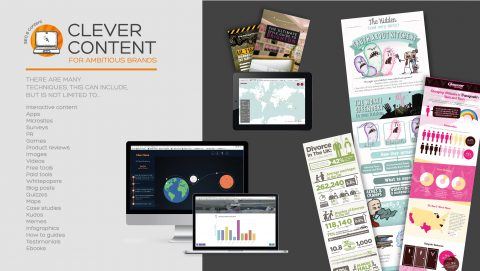
Organic social media: This involves any content that you produce and post directly on a social media network, whether it’s a photo on Instagram or a meme you are sharing on Twitter. Social networks rely on being able to share strong organic content so that users keep returning to the network to keep seeing that network’s unique content.
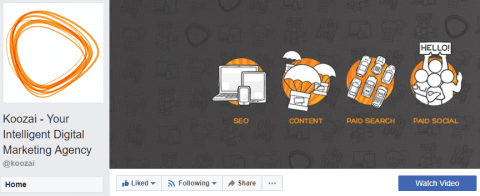
Businesses can post over social media using pages, business profiles, etc. The example below is the Koozai Facebook page, and we use this to share content and information about Koozai (and digital marketing in general).
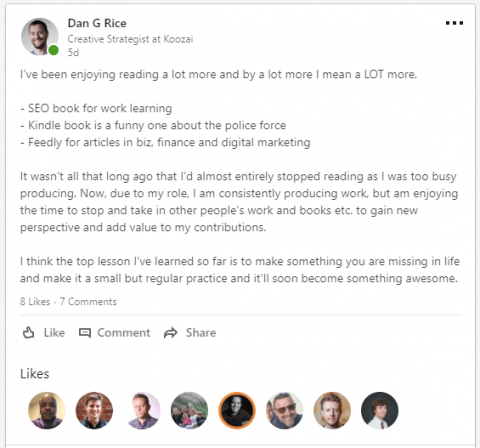 This next example is from my personal LinkedIn profile and shows that social networks can blur the lines between your personal and professional networks. It is important to remember this when posting from a personal profile, as this can be seen as a direct reflection of your company and how it operates professionally.
This next example is from my personal LinkedIn profile and shows that social networks can blur the lines between your personal and professional networks. It is important to remember this when posting from a personal profile, as this can be seen as a direct reflection of your company and how it operates professionally.
Whenever you are considering organic social media strategies, it is important to remember that the goal of social media networks is to ensure that people stay on their website. This means that they will provide greater coverage or ‘reach’ to people whose content keeps users on the social media network and engaging in conversations with each other. On the flip side, they tend to reduce the reach of content that drives users away from the network and onto other websites.
This doesn’t stop it being a fun and exciting way to grow your audience. Provided you get the balance right, the social networks will work with you to share your content to a wider audience and to grow your following and/or community.
Earned Media
Definition: Earned media is the acquisition of free-of-charge publicity (unlike paid advertising) for your business, spokespeople and website online.
Earned media is attained by getting press mentions (or branded citations), positive reviews or links back to your content. It is facilitated by building relationships with key digital publications, journalists and influencers and will help build brand awareness, reputation and positive sentiment.
Technical SEO alone can’t guarantee increases in rankings without the support of proactive digital PR. Gaining branded mentions and backlinks on relevant, authoritative and reputable domains with high trust and citation flow will pass value and assist in elevating your brand to a better position than that of your competitors.
Earned media efforts will be predominantly the preserve of digital PR, but will also include elements of traditional PR; to understand the difference, read this: The Difference Between Digital PR and Traditional PR.
The key objectives of an earned media team are to drive awareness, build your authority within an industry and, ultimately, widen your audience of potential customers. However, the best way to go about earned media is to ensure that you are providing journalists with a great story and making it as easy as possible for them to tell it. If you can achieve that, you will secure the key results that will drive your business into the public eye on a more regular basis.
| Key Earned Media Metrics | ||||
| Referring domains | Backlinks from trusted domains | Citations and brand mentions | Contributing articles | Publicity value of media earnt |
An earned media strategy will focus on proactive and reactive PR. Proactive activities will include writing press releases to secure media attention, finding opportunities for interviews with spokespeople, news jumping to submit expert comment and writing contributing articles for leading industry websites. Reactive activities will include media monitoring for brand mentions or crisis communications in response to negative press about your company.
An example of proactive PR is securing opportunities to write opinion/expert pieces for popular websites. This can be seen here, with Koozai founder Ben Norman discussing marketing with The Drum Network: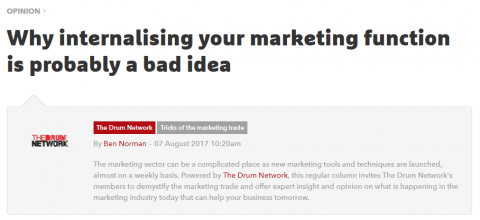
The intention of this piece is to ensure that one of our key personnel can demonstrate their industry knowledge, earning a brand mention and frequent links in exchange for providing the network and its readers with a valuable blog post and key information.
Whilst there are many differences between paid, owned and earned media strategies, it is important to remember that a converged or integrated digital marketing strategy encompassing all three elements will provide the best outcomes for you and your business.
The key takeaways for you to remember are:
- Determine your goals as a business
- Use these to formulate digital marketing goals and goals for each individual channel
- Design activities in each channel which support the efforts of the other areas
- Ensure that you are measuring the right metrics to determine whether or not your digital marketing strategies are successful
If you like what you’ve seen but don’t know what to do next, a great place to start learning more about paid, owned and earned media is Koozai TV. Our team will guide you through a series of sessions that help you develop your skills and will ensure that you are putting your best foot forward when it comes to digital marketing.
The post What is the Difference Between Owned, Earned and Paid Media appeared first on Koozai.com